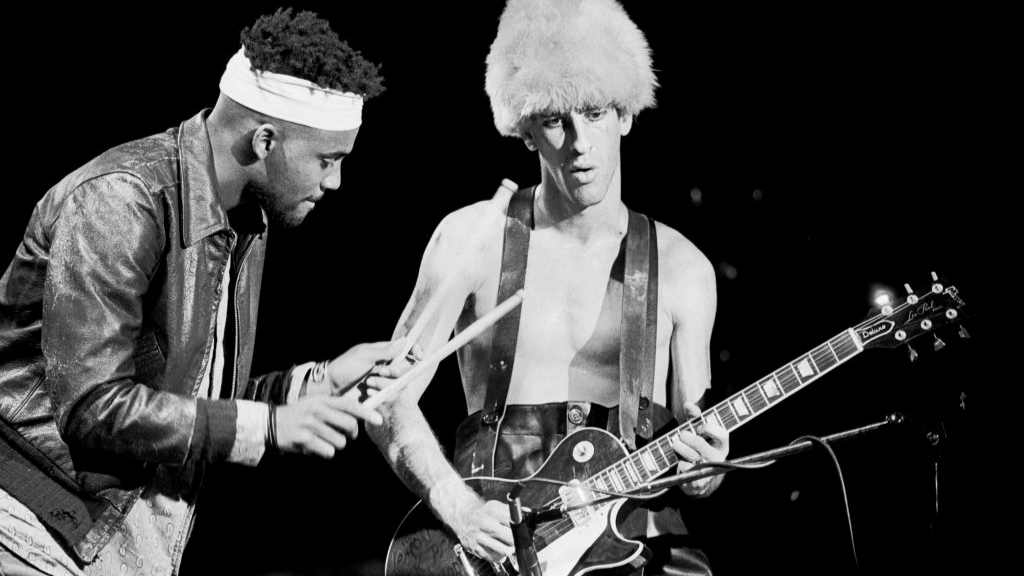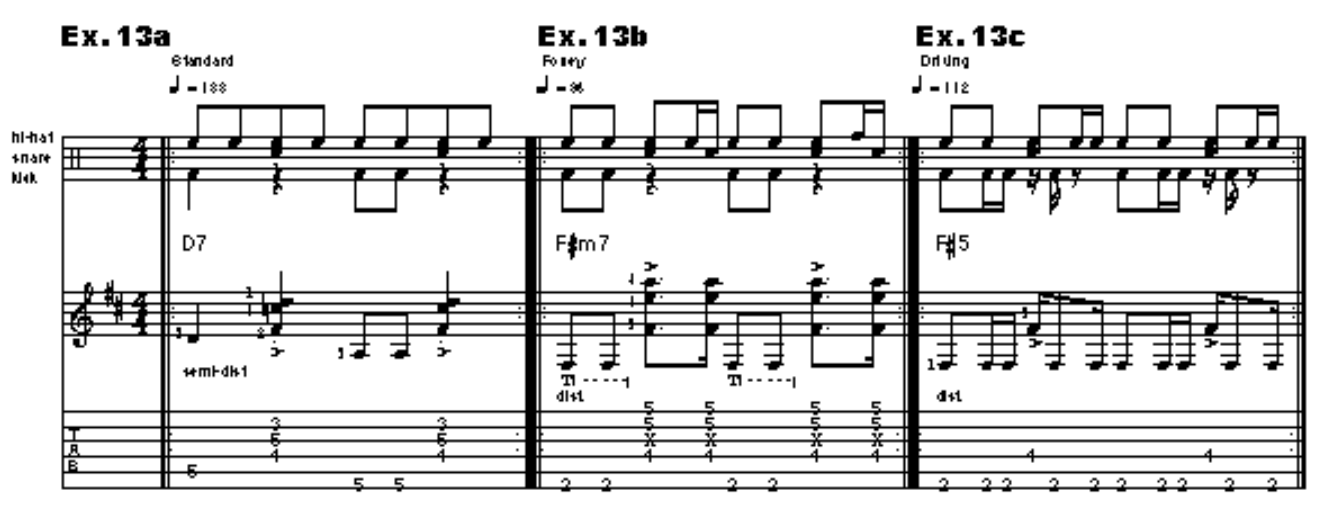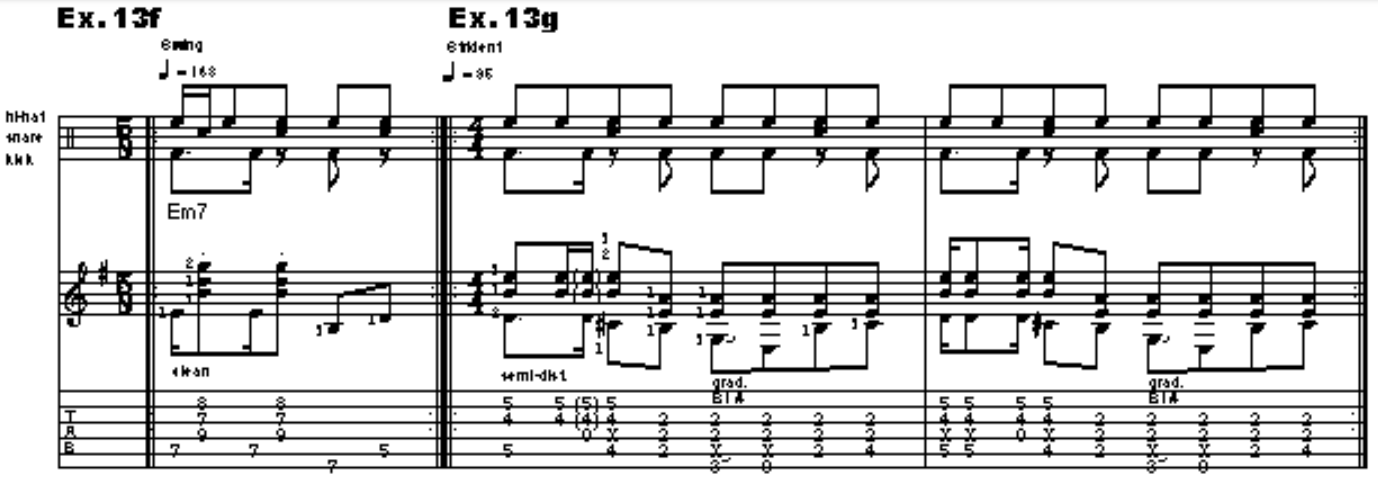Turn Mighty Drum Grooves Into Driving Rhythm Riffs
Any rudiment or drum beat can inspire a hotbed of guitar ideas – here’s how to make it work for you.

Deep inside every guitarist there's a frustrated drummer screaming to get out.
After all, take away those cumbersome notes and we're just a bunch of guit-drumming string chuckers.
So why, for all our similarities, have guitarists developed such a reputation for rhythmic deficiency? Simple – drummers are raised on rhythm, guitarists are not.
By the time we're struggling to barre our first F chord, most drummers have mastered the essential principles of drumming – the 26 "rudiments" – and are working diligently on their four-way independence.
Playing music from the perspective of another instrument can lead you down roads you might have otherwise ignored
Guitarists, who have no such regimen, stand to benefit from adapting rudiments and drum kit rhythms to their instrument.
Playing music from the perspective of another instrument can lead you down roads you might have otherwise ignored.
To get a handle on this concept, we'll examine three snare drum rudiments and apply various drum grooves to the fretboard.
All the latest guitar news, interviews, lessons, reviews, deals and more, direct to your inbox!
Keep in mind that the notes and chords in the following examples are of secondary importance to the rhythms.
Once each rhythm is internalized, there are infinite possibilities for note and chord choices.
Rudimentary, My Dear Guitarist
Ex. 1a illustrates the basic alternate sticking pattern of a single-stroke roll (rudiment No. 14) progressing from quarter- to 32nd-notes.
One could easily equate left/right sticking to down/up picking. In this sense, any continuously alternate-picked note or notes would be a single-stroke roll.

Ex. 1b assigns different pitches (G and F) to each hand. Pick every note at first, then incorporate pull-offs and hammer-ons for a more organic, guitaristic feel.
The eighth-note pull-offs create a sense of time transference between hands akin to left/right sticking (or, in this case, right/left).

Ex. 1c ventures beyond the 2-note trill by inserting a pedal D between the alternating Gs and Fs.
Think: different drum, same hand.
Develop a series of conceptually similar exercises incorporating dynamics (ppp to fff for example).
Reverse sticking on each example produces a mirror-image, retrograde version of the rudiment.
The remaining single-stroke rolls are notated in eighth-notes, but each should be drilled in the same manner as Examples 1a-1c.

Ex. 2 breaks three triads into upper and lower register components which alternate in single-stroke fashion.
The organ-like results, arranged here for fingerstyle, could also be played hybrid-style (middle and ring fingers alternating with pick) or completely flatpicked.

Ascending G and F triad inversions alternate with a pedal open-G chord in Ex. 3a.
Play the same thing descending, then reverse the order of the triads, i.e., F to G.

Ex. 3b puts these inversions to use outlining a I, IV, V progression.

Examples 4a-4d feature punctuated chord fragments over an open-A pedal.
Examples 4a, 4b, and 4c are A7-flavored vamps, while 4d emphasizes Am7.
Again, try reversing the order of the chords or play each measure in retrograde.

Our double-stroke roll (rudiment No. 1) adaptation follows the same drill.
Ex. 5a illustrates the roll and its sticking from quarter-notes through sixteenths, 5b adapts it using two notes, and 5c introduces a third pitch.

New phrasing options are available, since we now have two identical pitches in a row.
In the eighth-note portion of Examples 5b and 5c, a four-note down/up/ pull-off/up pattern emerges.
For the sixteenths, an initial downstroke sets up a continuous flow of upstrokes.

Ex. 6 features the broken triads from Ex. 2 applied to a double-stroke roll.
Alternate picking seems to work best, but you might also try index and middle fingers on the partials and thumb on the Gs.

Ex. 7a's double-stroke ascending G and F triad pull-offs, and Ex. 7b's I, IV, V progression, mirror Examples 3a and 3b respectively.

Again, note how the first downstroke in Ex. 7b sets a series of consecutive upstrokes into motion.

Examples 8a-8d focus on double-stroke versions of the previous A7 and Am7 partial-chord-over-pedal-A vamps.
Remember to play each example in retrograde as well as reversing the order of the chords.

The most useful rudiment for guitarists may be No. 21, the "paradiddle" (Ex. 9a).
This play-it-like-you-say-it pattern contains elements of both single- and double-stroke rolls, but its combination of alternating and repeating notes produces more interesting, almost polyrhythmic results – especially as the distance between notes and chords increases.

As before, Ex. 9b applies the rudiment to single G and F notes (try this one with octaves), and Ex. 9c introduces the pedal D.

Ex. 10 contains our broken I, IV, V chords superimposed onto a single paradiddle.


Things get really interesting when we apply the paradiddle rhythm to our ascending G and F inversions (Ex. 11a), pulled-off I, IV, V voicings (Ex. 11b), and partial chord/pedal-A vamps (Examples 12a-12d).

Don't forget the two variations for each example: Reverse the order of notes or chords and play each in retrograde.
Drum Licks to Guitar Riffs
Next, let's explore simulating drum kit rhythms on the guitar.
Heavyweights such as Hendrix and Page routinely transformed Mitchell and Bonham beats into killer electric guitar hooks.
The basic concept is to split the guitar into two registers that key off the kick and snare drums.
The bass part apes the bass drum and the chord/melody hits follow the snare.
Examples 13a-13g raise the question, "Which came first – the rhythm or the riff?"

Respectively Beatle-y, Hendrix-y and Page-y, Ex. 13a-13c use this formula verbatim.
The bass in Ex. 13a jumps from root to 5 between D7 snare/chord pops.
In Ex. 13b, the bass remains stationary while the chordal hits follow the snare accents and drags. The bass/bass, chord/chord pattern reflects a lopsided double-stroke roll.
Ex. 13c's galloping bass/snare assault uses just two notes an octave apart.

Ex. 13d is built on a bassline harmonized in fifths.
The accented 79 chord bomb on beat four creates a call-and-response effect within a single measure.
Ex. 13e, in Tower of Power tradition, drops a funky two-bar call-and-response phrase in the slot.
The only kick/snare whack left open is on the "one" of bar 2.

A popular 5/8 jazz guitar vamp, Ex. 13f follows the rule halfway, then subs a bass note for the last snare hit.
The final example, 13g, is a composite of the bass and rhythm guitar parts from Todd Rundgren's "Worldwide Epiphany" that I concocted while playing guitar on his '95 tour.
Though the upstemmed chord fragments were recorded as straight eighth-notes, the added syncopations help keep the original bassline intact.
This, combined with the additional parenthesized notes, makes the entire figure much easier to play without compromising its intent.
The syncopated rhythmic variation at the top of bar 2 deviates from the drum groove just long enough to create a call-and-response riff of anthemic proportions.

Getting the idea?
Any rudiment or drum beat can inspire a hotbed of guitar ideas. Stealing from drummers is fun and profitable!
Analyze any beat that turns you on and put it to work in your repertoire.
Pick up a drum book, check out the other 23 rudiments, and, while you're at it, buy some sticks!
